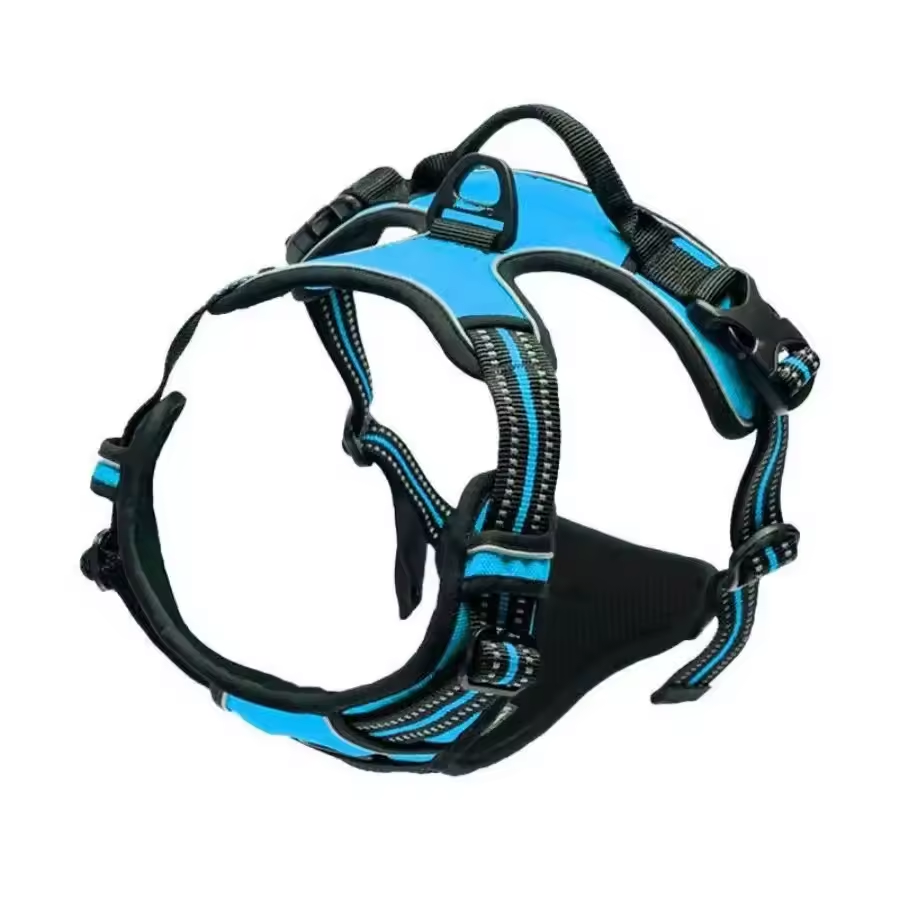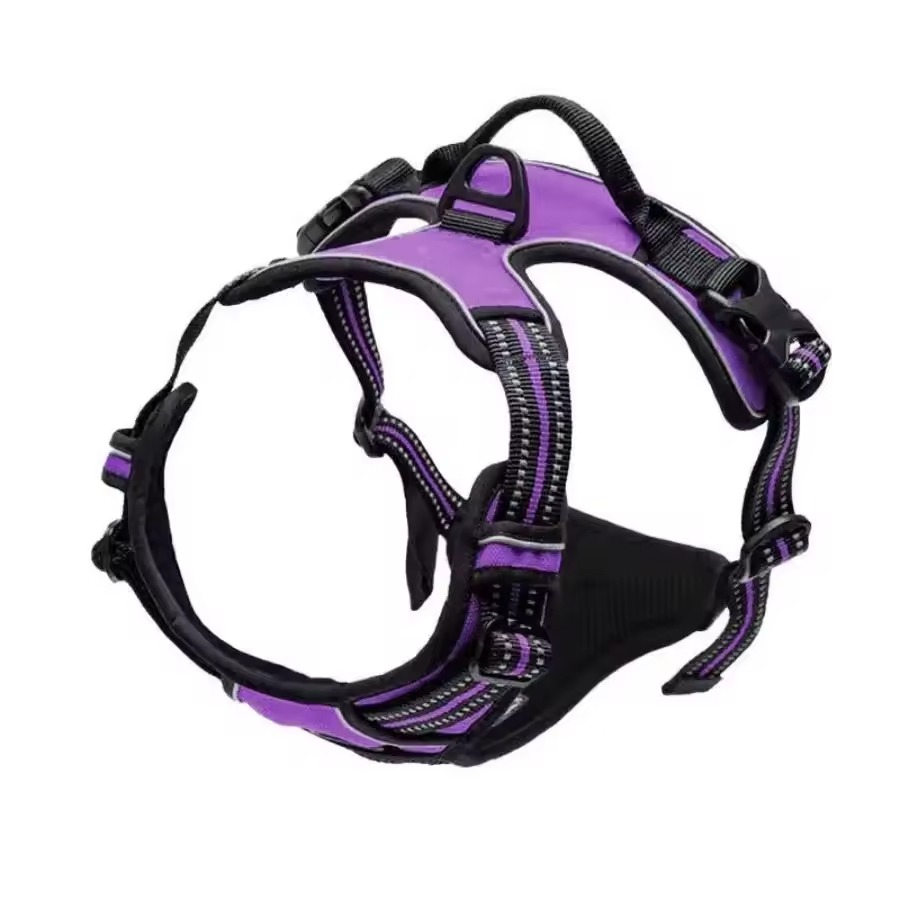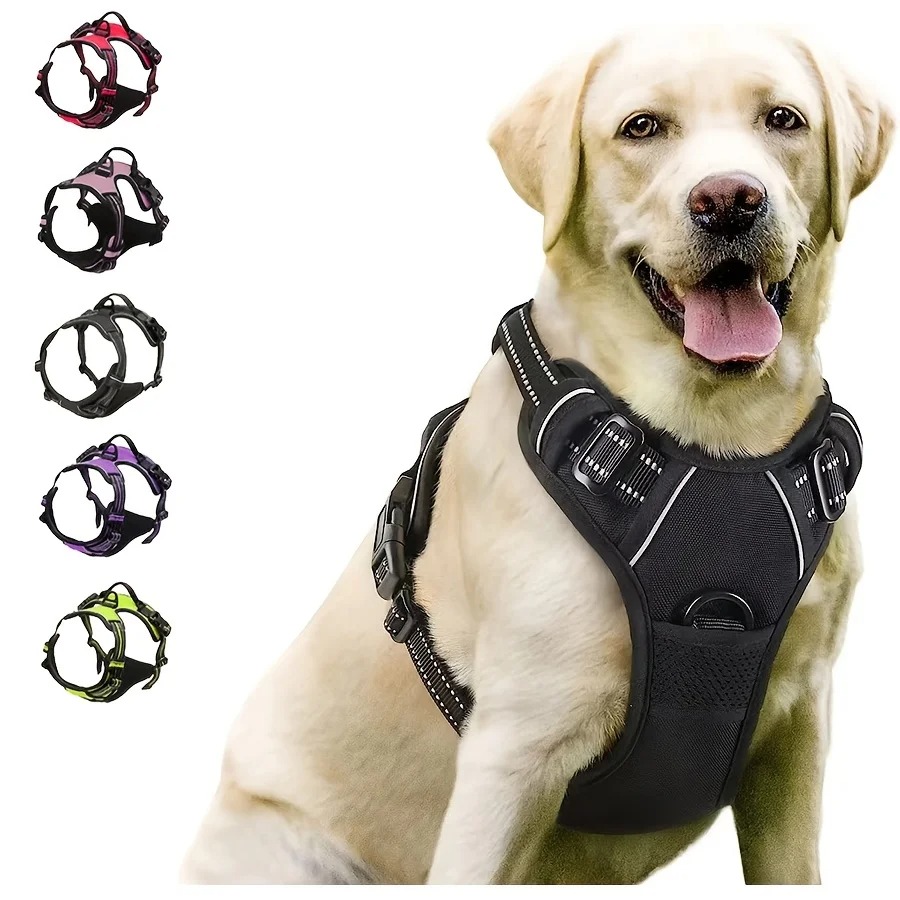Introduction to Heavy Duty Dog Harnesses
For dog owners seeking control and safety, a heavy duty dog harness is essential. It offers support for walking, training, and outdoor activities. These harnesses are designed for durability. They withstand the strength and energy of larger, more powerful dogs. A well-chosen harness ensures comfort for your pet and peace of mind for you. In this guide, we’ll explore the essential features of these harnesses. We’ll help you understand why they are a preferred choice for many dog owners.

Choosing the right harness comes down to more than just size and strength. Factors like material, fit, and design also play a crucial role. Throughout this guide, we’ll focus on the aspects that make a harness ‘heavy duty’. We’ll discuss the materials and construction that provide added strength and durability. With the right heavy duty dog harness, both you and your furry friend can enjoy every adventure with confidence.
Key Features of Heavy Duty Dog Harnesses
When choosing a heavy duty dog harness, key features are paramount. Here we’ll delve into the attributes that make a harness robust enough for your active canine. It’s important to look for certain characteristics that suit your dog’s needs.
High-Quality Materials
Look for harnesses made from strong fabrics. Materials like nylon or leather are common and long-lasting. They resist wear from energetic activities. Harnesses may also feature metal components for extra strength.
Reinforced Stitching
A harness must have solid stitching to handle pulling and movement. Reinforced stitching enhances the harness’s lifespan. It prevents tearing and ensures your dog’s safety.
Adjustable Straps
A proper fit is crucial for comfort and control. Adjustable straps allow you to tailor the harness to your dog’s body. This flexibility accommodates growth and weight changes over time.
Padded Chest and Back Plates
Comfort is as important as strength. Padded plates protect your dog’s body from pressure and strain. They distribute force evenly when your dog pulls.
Reflective Elements
For those who walk their dogs at night, reflective features are beneficial. They improve visibility and safety in low-light conditions. Reflective harnesses catch light and alert others to your dog’s presence.
Easy-to-Use Buckles
Look for harnesses with buckles that are simple to fasten and release. This makes it easy to put on and remove the harness, even when in a hurry.
Each of these features contributes to a harness’s effectiveness. Ensuring these elements are present can enhance your dog’s safety and your peace of mind on walks.

The Importance of Durability and Strength
When selecting a heavy duty dog harness, durability and strength stand out as critical features. They are what keep your dog secure during intense activities. Let’s break down these crucial elements:
- Resist Wear and Tear: Harnesses face rigorous demands. They should withstand running, jumping, and pulling. Strong materials and construction ensure they hold up over time.
- Support for Strong Breeds: Larger dog breeds need sturdy gear. A durable harness can manage the force of a powerful dog without fraying or breaking.
- Safety in Control: A heavy duty harness maintains its shape and form. This helps you manage your dog’s movements with confidence.
- Long-Term Use: A strong harness is a one-time investment. It’s designed to last, avoiding the need for frequent replacements.
- Outdoor Adventures: Dogs who are often outdoors need gear that resists the elements. Solid harnesses withstand various weather conditions without deterioration.
Overall, the durability and strength of a dog harness are essential for both the dog’s safety and the owner’s ease of mind. They are non-negotiable aspects for any responsible pet owner. By investing in a harness that is built to last, you ensure your pet’s comfort and protect your investment.
Different Types of Heavy Duty Dog Harnesses
When searching for a heavy duty dog harness, it’s crucial to consider the different types available. Each type caters to specific needs and situations. Here we will discuss the most common varieties to help you choose the best option for your dog.
Standard Harnesses
Standard harnesses are the most basic type. They provide good control and are suitable for daily walks. They typically have a simple design with one loop around the neck and another around the ribs. These harnesses often feature adjustable straps for a secure fit.
No-Pull Harnesses
No-pull harnesses are designed to discourage pulling. They have a front clip that deters your dog from using their full strength to pull forward. This type can be especially helpful for training powerful dogs to walk without tugging.
Step-In Harnesses
Step-in harnesses are named for the way dogs step into them. They are laid on the ground and your dog steps into the leg holes. Then, you pull the harness up and clip it over the back. This type is perfect for dogs that don’t like harnesses pulled over their head.
Tactical Harnesses
Tactical harnesses are built for durability and functionality. They come with extra features like handle grips, and attachment loops. These are ideal for working dogs or those that embark on outdoor adventures.
Vest Harnesses
Vest harnesses provide more coverage and support. Made with more padding, they distribute pressure evenly across the chest and back. These are suitable for dogs with sensitive skin or those who need added comfort.
Each type of heavy duty dog harness has its pros and cons. Your choice should depend on your dog’s size, breed, and the activities you plan to do together. Remember to consider the features discussed earlier to ensure you get a harness that’s just right for your canine companion.
How to Measure Your Dog for the Perfect Harness Fit
Finding the perfect fit for a heavy duty dog harness is essential for comfort. An ill-fitting harness can lead to discomfort and even injury for your dog. Here’s how to measure your dog to ensure the perfect harness fit:
Use a Tailor’s Tape Measure
To begin, find a flexible tailor’s tape measure. It allows you to measure your dog’s body accurately. Stay away from rigid rulers that can’t wrap around your dog’s curves.
Measure the Neck
Circle the tape around the base of your dog’s neck. Note the measurement where the tape intersects. This is where the harness will sit, not too tight or too loose.
Measure the Chest
Find the widest part of your dog’s ribcage. This is usually a few inches behind their front legs. Wrap the tape around this area for the chest measurement.
Check for Weight and Growth
Remember, your dog may grow or change weight. Always consider this when choosing heavy duty dog harnesses. Adjustable straps are a good feature for a changing body size.

Account for Breed-Specific Sizes
Some dog breeds have unique body shapes. A greyhound and a bulldog might weigh the same but need different harness sizes.
Verify Sizing Guides
Compare your dog’s measurements with the manufacturer’s sizing guides. Each brand may vary, so it’s important to check before you buy.
Don’t Forget Comfort
Although the right size is critical, also look for padded straps. They add comfort and prevent rubbing against your dog’s skin.
By taking careful measurements and comparing them to the sizing charts provided by harness manufacturers, you can ensure a comfortable and secure fit for your dog’s heavy duty dog harness. Keep in mind that every dog is different, and what works for one may not work for another, so patience and attention to detail are key in this process.
Tips for Selecting the Right Heavy Duty Dog Harness
When in the market for a heavy duty dog harness, making the right choice is vital. Below are practical tips to help you select the best harness for your canine.
Assess Your Dog’s Activity Level
Consider how active your dog is. A more active dog will require a sturdier harness.
Think About Your Dog’s Behavior
Does your dog pull or jump a lot? Look for a harness that can withstand such behaviors.
Research Different Brands
Not all harnesses are created equal. Compare brands to find one with a strong reputation.
Read Customer Reviews
What have other dog owners experienced? Positive reviews often signal a good quality harness.
Check the Harness’s Weight Limit
Ensure the harness can support your dog’s weight securely.
Examine the Harness Closely
When you have a harness in hand, check its weight and feel the materials used. Sturdy and dense materials are often indicative of a solid harness.
Prioritize Adjustable Features
A harness with multiple adjustment points is preferable. It allows for a better fit as your dog grows or changes in size.
Verify Return Policies
Understanding the return policy is essential in case the harness doesn’t fit. Always purchase where you have the option to return or exchange.
Seek Out Value, Not Just Price
Invest in a quality harness that will last, rather than going for the cheapest option.
By following these tips, and keeping in mind the heavy duty dog harness features previously discussed, you can make an informed decision. This way, you will invest in a harness that offers durability, safety, and comfort for your beloved pet.
Safety Considerations for Using Heavy Duty Harnesses
When using a heavy duty dog harness, safety is paramount. Making sure you use the harness correctly can prevent injuries to your dog and ensure safe outings. Here are some vital safety considerations to keep in mind when using a heavy duty harness:
- Inspect Before Each Use: Before putting on the harness, look for any signs of wear or damage. Check for frayed straps, broken buckles, or loose stitching.
- Proper Fitting: A harness that fits well is safer. Ensure the harness is snug but not too tight – you should be able to fit two fingers between the harness and your dog’s skin.
- Gradual Introduction: If your dog is new to wearing a harness, introduce it slowly. Let them wear it for short periods to adjust before going for a full walk.
- Avoid Overloading: Don’t attach too many items to the harness. It can cause discomfort or imbalance your dog.
- Train Consistently: Teach your dog not to pull. Even with a harness designed to prevent pulling, training is key to a safe walking experience.
- Use with Supervision: Never leave your dog unattended with the harness on. They could get entangled or injured if they try to escape.
- Mind the Weather: During hot weather, ensure the harness is not causing your dog to overheat. Likewise, check that it’s not too cold and wet in colder climates, which could cause discomfort.
- Evaluate Your Dog’s Comfort: Keep an eye on your dog’s behavior. If they seem uncomfortable, adjust the fitting or check for any issues with the harness.
Ensuring these safety considerations are met will make for a happier, healthier walk with your furry friend. Keeping your dog safe is just as important as the durability and durability of their heavy duty dog harness.
Maintaining and Caring for Your Dog Harness
To keep your heavy duty dog harness in top condition, regular maintenance is key. Here’s what you need to do:
Clean Regularly
Dirt and sweat can break down materials. Clean the harness with mild soap and allow it to air dry fully.
Inspect for Wear and Tear
Before each use, check for any damage. Look for frayed straps, loose threads, or worn buckles.
Store Properly
When not in use, hang the harness in a dry place. Avoid folding it as this can weaken the material over time.
Follow Manufacturer’s Care Instructions
Each brand may have specific care guidelines. Make sure to read and follow these to avoid damage.
Address Repairs Promptly
If you notice any damage, fix it right away. Delaying repairs can lead to more serious issues or safety risks.
Following these steps will ensure your harness stays strong and reliable. Your dog’s comfort and safety depend on a well-cared-for harness.